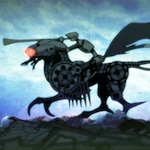 A widely circulated anecdote about THE MATRIX (I believe coming from an interview on the DVD extras) says that when the Wachowskis pitched the movie to producer Joel Silver they showed him Mamoru Oshii’s 1995 anime film GHOST IN THE SHELL on video and said, “We wanna do that for real.”
A widely circulated anecdote about THE MATRIX (I believe coming from an interview on the DVD extras) says that when the Wachowskis pitched the movie to producer Joel Silver they showed him Mamoru Oshii’s 1995 anime film GHOST IN THE SHELL on video and said, “We wanna do that for real.”
The internet being the internet, that story evolved into the usual exaggerations – THE MATRIX is nearly a scene-for-scene remake, so close they had to ask permission, bullshit like that. There’s a cool video on Youtube showing images from THE MATRIX that seem inspired by or lifted from GHOST – lines of green code, plugs in the back of necks, a cool way that Neo lands – but it runs 1:16. There are quite a few other parts in THE MATRIX, in my opinion.
Still, the influence is undeniable, and the Wachowskis have been open about it. You can see what they were interested in there: the intersections between man and machine, super-powered battles in the midst of or above a large city, badasses in sunglasses taking on a bunch of armored cops, or being clawed at by inhuman machines. They did all that for real.
While promoting the movie in Japan the siblings took the opportunity to visit some of the animators they admired, and the idea came up that there could be anime inspired by the movie inspired by anime. So while working on the live action sequels, they also recruited several directors and animation studios to turn their anime-for-real into a real anime, creating nine shorts exploring the world of THE MATRIX from different angles and in different styles.
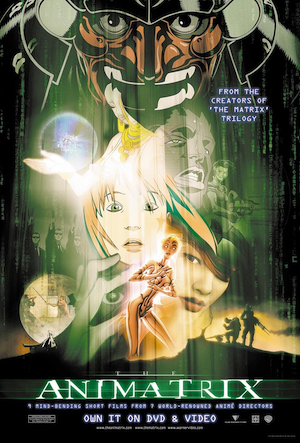 Released in proximity to THE MATRIX RELOADED, a few of the shorts fill in backstory or set up events and characters in the sequel. Others tell stories about new characters within the universe. Four of them were “released over the World Wide Web” on thematrix.com starting in early 2003. It was quite an event, not only because it was a cool idea to see THE MATRIX in animation, but because people were hungry for hints about what the fuck the upcoming sequels were gonna be. Also it took forever to load videos back then, so you had some extra anticipation time there.
Released in proximity to THE MATRIX RELOADED, a few of the shorts fill in backstory or set up events and characters in the sequel. Others tell stories about new characters within the universe. Four of them were “released over the World Wide Web” on thematrix.com starting in early 2003. It was quite an event, not only because it was a cool idea to see THE MATRIX in animation, but because people were hungry for hints about what the fuck the upcoming sequels were gonna be. Also it took forever to load videos back then, so you had some extra anticipation time there.
Two months before RELOADED’s May 15, 2003 release date, The Final Flight of the Osirus played theatrically in front of DREAMCATCHER. The full ANIMATRIX anthology was released on DVD and VHS in June.
Written by the Wachowskis and directed by Andrew R. Jones, The Final Flight of the Osirus is actually not anime at all. Rather than hand drawn animation, it continues in the photorealistic computer animation style of its soon-to-be-defunct studio Square USA’s uncanny-valley-istic FINAL FANTASY: THE SPIRITS WITHIN.
The crew of a hovercraft much like Morpheus’s Nebuchadnezzar discover a massive army of Sentinels (the robotic squids) drilling toward the human-survivor-city of Zion. They know it’s too late to get away themselves, but they try to stay alive long enough for Jue (Pamela Adlon, THE ADVENTURES OF FORD FAIRLANE) to enter The Matrix and drop a package into a mailbox that will act as a warning to Zion. Apparently this sets up the associated video game Enter the Matrix, and the brave actions of the crew are also referred to in RELOADED. The Sentinel army now known to be approaching are a threat throughout the movie.
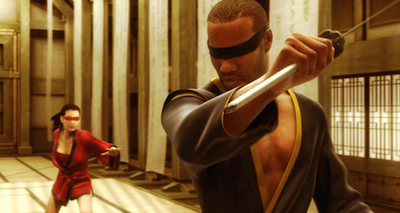 The main thing I remembered about this one was the animation style, though I believe at the time I recognized it was an improvement over FINAL FANTASY. According to an NBC story at the time the short on its own cost $5 million and was animated over 13 months on about 800 machines. The article says it “arguably stands as the best big-screen example of computer-generated imagery, or CGI” and marvels at details like visible veins, pores and goosebumps on the characters, which it says are made up of around 8 times as much information as the FINAL FANTASY characters. Even so, they were wise enough to open on two characters wearing blindfolds, since dead-looking eyes were the biggest weakness of the technology at the time.
The main thing I remembered about this one was the animation style, though I believe at the time I recognized it was an improvement over FINAL FANTASY. According to an NBC story at the time the short on its own cost $5 million and was animated over 13 months on about 800 machines. The article says it “arguably stands as the best big-screen example of computer-generated imagery, or CGI” and marvels at details like visible veins, pores and goosebumps on the characters, which it says are made up of around 8 times as much information as the FINAL FANTASY characters. Even so, they were wise enough to open on two characters wearing blindfolds, since dead-looking eyes were the biggest weakness of the technology at the time.
In the long run Jones won the argument about photorealistic animation – he was later the animation supervisor for Jon Favreau’s JUNGLE BOOK and LION KING remakes. (I thought the former was really good and the latter at least looks beautiful.) And watching Osirus now I’m able to just go with it and appreciate this as a cool little story of sci-fi valor. It also brings some horniness into The Matrix – before the trouble starts, Jue and Thadeus (Kevin Michael Richardson, BASEKETBALL) spar in a simulation like Morpheus’ dojo, but they playfully slice each other’s clothes off with swords and then try to peek at each others’ junk.
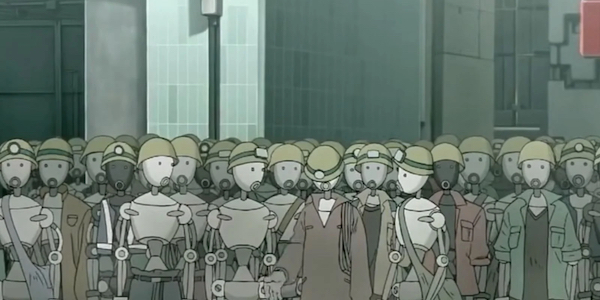
The Second Renaissance Parts I and II, written and directed by future FURY ROAD concept artist Mahiro Maeda, based on a comics story by the Wachowskis and Geof Darrow, is the world-building-est portion of the project. Presented as a video file from the Zion Archives (which remind me of “the Akashic Records” on the Prince album The Rainbow Children), it uses a narrator and animated file footage to fill in details about the rise of the machines and the fall of humanity.
While the machines in THE MATRIX are a faceless evil, The Second Renaissance shows that mankind fuckin started it. In the mid-21st century, artificially intelligent robots work as servants, and have no rights. When one named B1-66ER is put on trial for killing his owner to avoid being junked, it leads to worldwide unrest. Eventually machines segregate from humanity and form their own massive city called 01. They try to make peace and send android ambassadors (one with a top hat and mustache!) to the U.N., but humans fear them and start a nuclear war. It turns out the sunless skies we see in the movie are not a result of the nukes, but a later, separate plan to pollute the air and take away the machines’ access to solar power, thus leading to their “let’s just use humans as batteries” plan.
Though unmistakably a “here, let me explain the backstory I came up with” presentation, I find The Second Renaissance captivating and at times powerful. Maeda and the animators skillfully mimic handheld news cameras, chyrons, various video formats and glitches to add a sheen of realism to disturbing segments of man’s inhumanity to machines. I kinda think it’s in poor taste that they have an allusion to infamous Vietnam War execution footage, but it definitely gets the point across.
I don’t consider this the best of the bunch story-wise, but it’s definitely the one that most informs the live action sequels. Seeing the machines’ point of view doesn’t take away the righteousness of Neo’s cause; though the machines started out in the right, their lack of humanity leads them to indefensible actions like experiments in human torture and, of course, using us as a power source without permission. That they tried nicer things first and we should’ve worked something out doesn’t make this outcome any less unacceptable. But this history does show that it’s much more complicated than we knew, and therefore the solution may not be as straight forward as we’d hope.
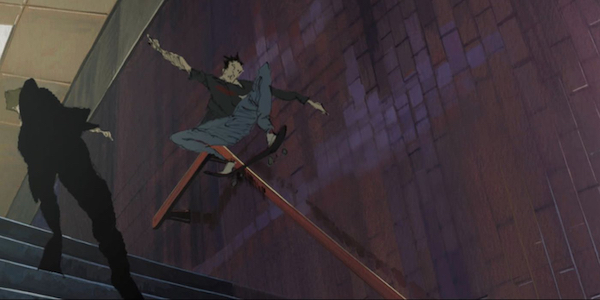
Kid’s Story, written by the Wachowskis and directed by Shin’ichirô Watanabe (Cowboy Bebop), is another direct tie-in to RELOADED, an origin story for the new character The Kid (Clayton Watson). Living as an ordinary high school student in The Matrix, this kid senses that something isn’t right, communicates with Neo, gets chased by agents at school, rides a skateboard through the halls, and “self substantiates” – wakes himself up without a red pill, previously believed to be impossible (even though somebody had to have done it at some point, right?)
I like the sketchy, flowing animation on this one, but the story creeps me out. Maybe it’s because I’ve seen that documentary A GLITCH IN THE MATRIX, where we hear from that guy who murdered his parents under the delusion that he was really living in The Matrix. It’s hard not to think of troubled minds like that when The Kid jumps off a school building, committing suicide in The Matrix but waking up in the real world.
My other complaint about this one is that it sets up unreasonable expectations for The Kid to do some sick kick flips or rail slides in RELOADED. He is never seen with a skateboard in live action. Shame on you, Wachowskis.
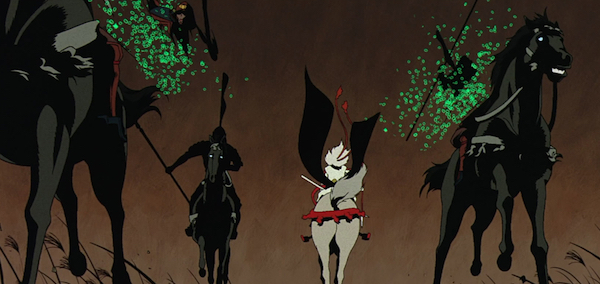
Program, written and directed by Yoshiaki Kawajiri (NINJA SCROLL, VAMPIRE HUNTER D: BLOODLUST, HIGHLANDER: THE SEARCH FOR VENGEANCE), is the first real standalone story in the collection, and definitely one of my favorites. In a more clearly Japanese tradition than the others, it centers around a high flying rooftop battle in another training simulation. Cis (Hedy Burress, VALENTINE) is practicing in an artificial feudal Japan when a dude named Duo (Phil LaMarr, REAL STEEL) shows up in samurai armor. They spar and talk and eventually he lets slip that he’s trying to pull a Cypher – he has sold the squad out to the machines, hoping to return to the plugged in coppertop lifestyle, and he wants her to join him.
When she wakes up out of the simulation (spoiler) it turns out to have been a ruse – the program was designed to test her loyalties. She does not react to this news with the relief they seem to expect. This is a good mix of animated action and emotional wallop.
World Record, written by Kawajiri and directed by Takeshi Koike (Afro Samurai, REDLINE) is one of the most visually interesting shorts and the most imaginative as far as trying to find something that’s Matrix-applicable but entirely different from what everyone else is doing. This one’s about a competitive runner named Dan (Victor Williams, BOGGY CREEK II: AND THE LEGEND CONTINUES) whose intense concentration while trying to break the world record for the 100 meter dash causes him to become aware of The Matrix. The gangly-but-muscular character designs (described as “deformed” in interviews) and offbeat camera angles seem influenced by Aeon Flux and expressionistically capture the awe of elite athleticism.
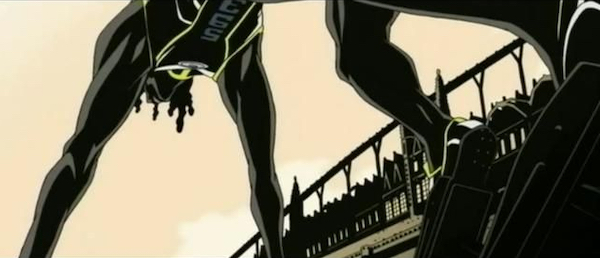
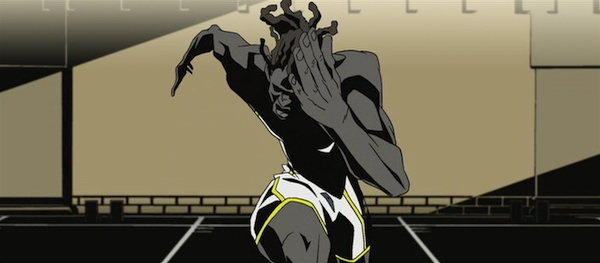
In the spirit of Bullet Time, the world slows down to show the movement of his body in stunningly animated detail. It’s harrowing and almost painful to watch the muscles in one leg snap and pop a piece at a time, and to see him somehow maintain balance and momentum to miraculously keep going and just barely stay out of the reach of a mob of agents.
Beyond, written and directed by Koji Morimoto (ROBOT CARNIVAL, MIND GAME [remix]) is a great one that almost wouldn’t have to take place in the MATRIX universe, but it makes it cooler that it does. It’s about some Japanese kids who like to sneak into an abandoned lot to play. They think it’s haunted, but we gather it’s actually a glitch in The Matrix that causes strange phenomenon like objects floating and broken bottles reassembling. They goof around and do things like jump face first in a place where they know they will float inches before hitting the ground. (It reminds me of that great part in POLTERGEIST where she discovers the spot in the kitchen that makes you slide across the floor.) Eventually agents catch on and ruin the fun. Ain’t that the truth.
The detailed backgrounds, natural looking light and immersive sound design really create a strong sense of place and of what it’s like to be a kid hanging out and playing all day. That’s what makes this one really great, regardless of the sci-fi trappings.
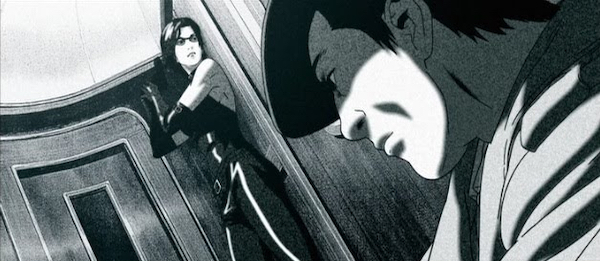
A Detective Story is from the same director as Kid’s Story, this time writing as well, and coming up with something much more interesting. As the title implies it’s a hard boiled detective yarn, and it’s about a private eye named Ash (James Arnold Taylor, FOODFIGHT!) who’s hired to track down a hacker called Trinity. (Yes, Carrie-Anne Moss does the voice.) Ash eventually finds her and meets with her on a train. She removes one of those robotic bugs from his eye and together they try to escape the Agents who are using him to trap her.
This is a cool little story animated with a black and white mimeograph sort of look, and I like how it’s not really required to be consistent with the movies. Its version of The Matrix is a retro-present with lots of fedoras and manual typewriter computer keyboards kinda like in BRAZIL.
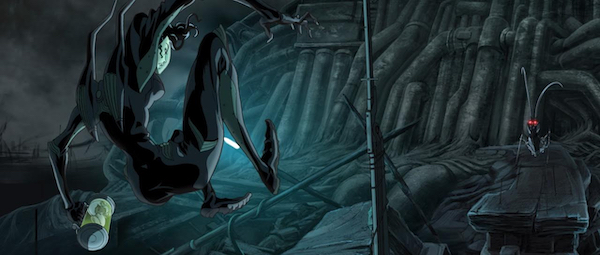
The last and in my opinion best segment is Matriculated, the one that actually is written and directed by Aeon Flux creator Peter Chung. (Which means this isn’t anime either – Chung and the studio, DNA, are American.) It’s about a group of red pilled human rebels running an unorthodox operation on the surface. Alexa (Melinda Clarke from RETURN OF THE LIVING DEAD III!) captures a “runner” robot and brings it to a lab, where they plug it and themselves into a machine to explore a bizarre psychedelic virtual world together.
Maybe it’s meant to be another simulation, but I like to think they’re jacking this machine into the human subconscious – The Matrix in reverse. Machines subjugate humans by putting them into a metaphorical dream, while these humans are trying to free a machine by putting it into a literal dream. Their goal is to convert machines to humanity’s cause by making them experience the human mind and emotions. They discuss that it would be easier to try to reprogram the robots, but they think the only way to do it is to give them free will, and let them decide on their own. A very principled approach, and not necessarily portrayed as probably-foolish like Dr. Frankenstein’s plan to domesticate zombies in DAY OF THE DEAD.
During the 2003 Seattle International Film Festival I was waiting in line at the Egyptian Theatre for a movie – it might’ve been the world premiere of Stuart Gordon’s KING OF THE ANTS – and THE ANIMATRIX was screening before it. After it ended I saw a guy talking to a camera crew out front, was told he was one of the directors who had been there to do a Q&A, and realized he was Chung. I remember his hair was very tall at the front, kind of like a pompadour, or like a hairstyle that one of his characters might have.
That’s my whole story. I don’t know why I told you that. But that guy is a genius, I wish he got to make more stuff. Right after this he did the half hour animated movie tie-in THE CHRONICLES OF RIDDICK: DARK FURY. I enjoyed seeing his unique designs and animation in the Riddick universe, but it definitely seemed to be a for-hire apply-cool-visuals-to-our-script kind of job, which is not the best use for such a fiercely original artist. Matriculated, on the other hand, feels pure – a genuine opportunity to use the ideas behind the MATRIX movies as a jumping off point for his own bizarreness and philosophical explorations. It’s also just some stunning looking animation – his recognizable design style with the advantage of digital coloring techniques that didn’t exist when he made Aeon Flux, and seamless integration of CG elements such as the robot characters.
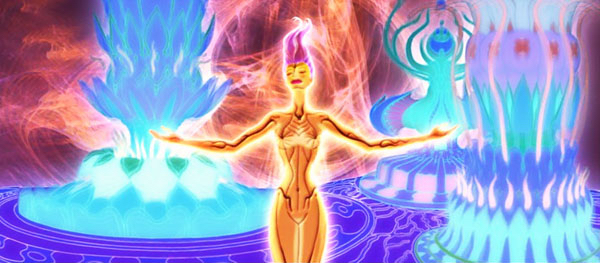
THE ANIMATRIX was just a cool idea, and one that seems pretty natural in the world of comic books the Wachowskis came out of. The Hellraiser series they did some writing for (credited to Lana under her previous name) was an anthology of short stories with wildly varied art styles (often fully painted), with different writers introducing new characters and places in the Hellraiser universe – what if a building was a puzzle box, what if Cenobites were in the old west, etc. Lana’s contributions included a story set in Apartheid-era South Africa and three volumes of Book of the Damned: A Hellraiser Companion which, foreshadowing their approach to The Second Renaissance, attempts to expand on the movies’ mythology in the form of clippings from diaries, tomes and research manuals.
Just by its very nature as animation and a DTV release, I don’t think THE ANIMATRIX was as widely known or seen as the live action features it was a companion to. But it reportedly sold 2.7 million copies, and I think it was generally pretty well received. It was also somewhat influential. In 2008 Warner Brothers used a similar format for BATMAN: GOTHAM KNIGHT, made up of six anime shorts by different directors and meant to take place in the same world as the Christopher Nolan DARK KNIGHT trilogy. (So, just for the record, Killer Croc exists in the Nolanverse. No takebacks.) More recently, Disney produced a series of anime shorts called STAR WARS: VISIONS, though these were presented as separate episodes on Disney+ rather than an anthology.
I enjoyed all of the aforementioned projects, but the latter two are fun just because you get to see different artists interpret or play off of famous Batman or Star Wars concepts. THE ANIMATRIX has that going for it too, but I think it really expands the scope of the story between chapters, and with The Second Renaissance and Matriculated it adds new depth and perspective to the live action movies.
By the end of this movie we’ve seen anime interpret the Wachowskis’ interpretation of anime, we’ve seen their stories told in animation and their concepts filtered through animators’ brains, we’ve learned how and why the machines rose and took over the world, and that there’s a possibility some of them could learn to sympathize with us. And I think that makes it an integral part of the larger story. Not bad for what’s basically internet marketing and a promotional DTV tie-in movie.

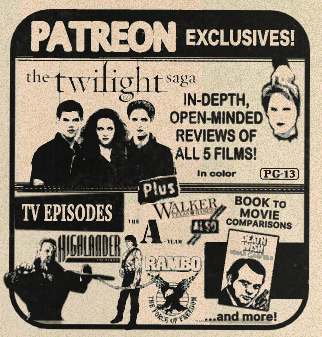

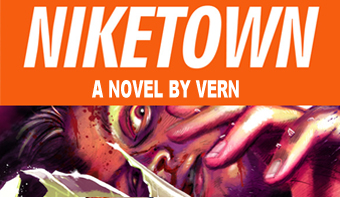
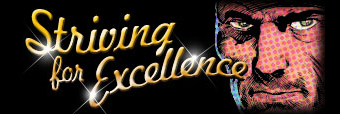
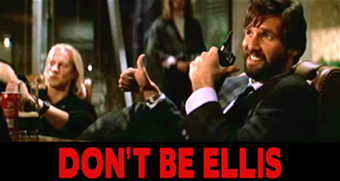










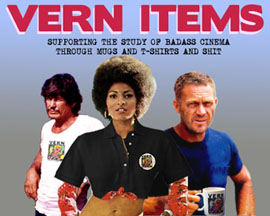









December 14th, 2021 at 10:09 am
I remember this being my first disappointment of the MATRIXverse.I rented the DVD the day it came out (The good ol days of going to the video store right after school and being able to snatch most of the new releases), but thought that most stories were boring and nearly all of them were depressing as fuck. Not to mention that the backstory was a bit of a lame take on the classic I ROBOT plot, made the whole thing extra disappointing to me.
It was indeed quite the even though. Just a week or two after its release, it even ran on free TV, in a heavily advertised last minute schedule change. (I think they dropped new episodes of FUTURAMA and MALCOLM IN THE MIDDLE for it and it became only the day before know, that they were going to show it.)
WORLD RECORD was for some reason my favourite. Can’t remember why, but something really clicked with me, that didn’t click in any of the other stories.